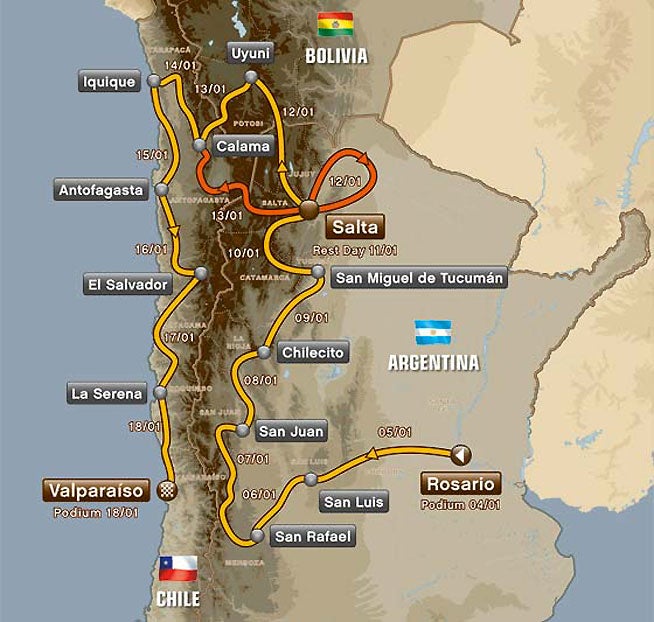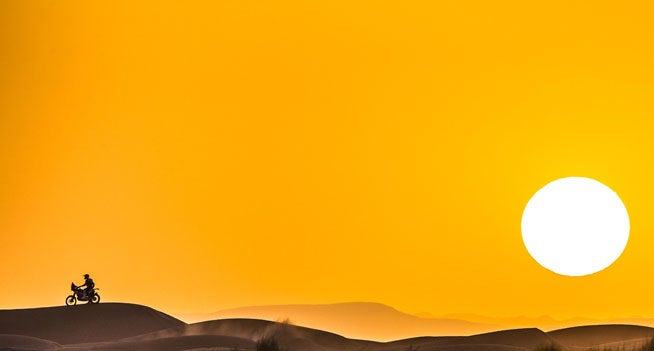Here is the official route map along with brief stage explanations of the 13 stages that will make up the 2014 Dakar Rally.

Sunday, January 5
Stage 1: Rosario – San Luis
• Liaison sections: 629 km
• Special stage: 180 km
The competitors will begin with a stage along the road in the region of Cordoba. The course features narrow tracks that will require serious concentration, as there are several blind jumps along the route.
Monday, January 6
Stage 2: San Luis – San Rafael
Motorcycles – Quads
• Liaison sections: 365 km
• Special stage: 359 km
Cars
• Liaison sections: 365 km
• Special stage: 433 km
Trucks
• Liaison sections: 365 km
• Special stage: 400 km
Stage 2 will include the fastest special stage of the 2014 Dakar Rally, and it will also mark the first time that the riders have to negotiate sand dunes, with a 60-mile section of the grey dunes of Nihuil. The sand is firm, but experience will still play a huge part in thia stage.
Tuesday, January 7
Stage 3: San Rafael – San Juan
Motorcycles – Quads
• Liaison sections: 292 km
• Special stage: 373 km
Cars – Trucks
• Liaison sections: 295 km
• Special stage: 301 km
The rally switches from the dunes to the mountains for Stage 3, as the competitors head into the the Pre-Andes near the The Aconcagua Volcano, which at 22,837 feet is the highest mountain in the Americas. The motorcycle riders will climb as high as 14,000 feet during their special stage.
Wednesday, January 8
Stage 4: San Juan – Chilecito
Motorcycles – Quads
• Liaison sections: 210 km
• Special stage: 353 km
Cars – Trucks
• Liaison sections: 211 km
• Special stage: 657 km
Stage 4 will place a premium on the navigational skills of the motorcycle racers, who will be challenged right off the start and will also have to strategize to avoid excessive tire wear. They will have to cross rivers, descend the canyons in a Wild West setting and beware of the other participants: as the terrain allows wide open racing. The stage will present a great opportunity for overtaking other competitors.
Thursday, January 9
Stage 5: Chilecito – Tucuman
• Liaison sections: 384 km
• Special stage: 527 km
After two race days with completely separate routes, the motorcyclists and quads will race with the cars and trucks in the longest stage of the 2014 Dakar Rally. All will need to be extremely vigilant to succeed in the special stage, which will mostly be composed of sand. By the time they reach the bivouac in Tucuman, the candidates for the podium will likely have been whittled down to a select few.
Friday, January 10
Stage 6: Tucuman – Salta
Cars
• Liaison sections: 270 km
• Special stage: 424 km
Trucks
• Liaison sections: 394 km
• Special stage: 156 km
Motorcycles – Quads
• Liaison sections: 64 km
• Special stage: 400 km
Leaving Tucuman, the cars will head north and drive along part of the renowned Ruta 40 and continue on in the heart of one of Argentina’s most beautiful landscapes. The possibilities to widen the gap will be limited but the most skilled drivers may be able to seize the opportunity of adding a stage to their list of wins. A new trip to the mountains will take the motorcycles to the banks of the rivers. They will have to be on guard, especially near the end of the stage, as they will likely encounter animals of all sizes, which frequent the region.
Saturday, January 11
Rest day: Salta
Just reaching the rest day without being eliminated is a major accomplishment during each and every Dakar Rally, and accordingly, drivers and teams will be honored with a halfway podium and celebration at the bivouac in Salta. Thousands of spectators are expected to come and discover the Dakar Village, as they did in Tucuman last year, and take advantage of a variety of entertainment and activities. They will also get the chance to meet the race competitors, who will take the opportunity to recharge their own batteries.

Sunday, January 12
Stage 7: Cars-Trucks: Salta – Salta
Cars
• Liaison sections: 230 km
• Special stage: 533 km
Trucks
• Liaison sections: 230 km
• Special stage: 525 km
Motorcycles-Quads: Salta – Uyuni
• Liaison sections: 373 km
• Special stage: 409 km
After an all-too-brief respite, the competitors will resume with a mega-loop and a 500-km long special stage that will test the teams’ ability to adapt to changes of pace. While the cars and trucks once again run routes of different mileage, the motorcycles and quads will face a second marathon stage that will also mark their first visit to Bolivia. When they enter the country the riders will experience a maze of tracks through which they will have to navigate. The steep mountainous areas will be challenging, but the few villages along the route will make navigating less of a chore. The stage will conclude at the bivouac in Uyuni, set up on the edge of the salt flat at an altitude of just over 11,800 feet.
Monday, January 13
Stage 8: Cars-Trucks: Salta – Calama
• Liaison sections: 510 km
• Special stage: 302 km
Motorcycles-Quads: Uyuni – Calama
• Liaison sections: 230 km
• Special stage: 462 km
The competitors will cross the Andes Cordillera during Stage 8 and begin the Chilean part of the rally. A special transition stage has been marked out there for the last day that cars will negotiate a different route than the motorcycles and quads. The Salar de Uyuni is the largest salt flat in the world, and the motorcyclists route will take them around and across it. The route will stretching over more than 400 kilometres, and will also pass by several islands. The stature of the Tunupa Volcano (17,388 feet altitude) will be a permanent feature on the landscape.
Tuesday, January 14
Stage 9: Calama – Iquique
• Liaison sections: 29 km
• Special stage: 422 km
The 2014 Dakar will reach its most northern point in Iquique, where the competitors will see the ocean for the first time in the rally. The drivers and teams will then have to navigate the Atacama Dunes again after the first part of a special stage which is expected to be taxing. Dune specialists will certainly have an advantage over a distance of almost 150km, and thrills will be all but guaranteed during the last three kilometers of the descent to Iquique; there is more than a 30% difference in height from start to finish. The laws of gravity will be fully appreciated here.
Wednesday, January 15
Stage 10: Iquique – Antofagasta
• Liaison sections: 58 km
• Special stage: 631 km
The special stage, split into two sections with very different features, will begin with the descent toward the shores of the Pacific Ocean. Any advantages gained in the stage the day before may well be increased in the sand during the first two hundred kilometers of this stage, but even more skill will be required to tackle the sections of fesh-fesh—fine sand that looks like solid ground but behaves like soft mud—in the second part of the stage. Once this difficult area is behind the competitors, they will twist and wind along the region’s mine tracks before being welcomed by the majestic arch of La Portuda, a stone’s throw from the bivouac in Antofagasta.
Thursday, January 16
Stage 11: Antofagasta – El Salvador
• Liaison sections: 144 km
• Special stage: 605 km
In addition to the distance, the rally competitors will be seriously tested by the hazards of the Atacama Desert, which should favor those who specialize in the desert terrain found in most North American off-road races. Along with having to cross mine tracks and many riverss, the competitors will have to tackle the heart of the Dunes of Copiapo, where even the fastest motorcyclists are expected to spend seven hours at the controls. This stage is expected to be the key stage in the 2014 Dakar Rally, and there will be no shortage of opportunities for competitors to fall into deep peril or perhaps make a winning comeback in the race.
Friday, January 17
Stage 12: El Salvador – La Serena
• Liaison sections: 349 km
• Special stage: 350 km
The site chosen in El Salvador towers at high altitude over the usual location of the bivouac in Copiapo. This was done to ensure that the Camanchaca—the morning mist which sometimes hinders the start of the stages—will be avoided. Sand will be a part of the route again, with a big string of dunes to be overcome at the end of the special stage. In categories where competitors are neck and neck, this stage still has the potential to jumble the running order.
Saturday, January 18
Stage 13: La Serena – Valparaiso
• Liaison sections: 378 km
• Special stage: 157 km
Before admiring the hillsides brought to life by the houses in Valparaiso, the competitors will have to climb the hills planted with cacti during the rally’s last special stage. The finish line will practically be in sight, but every year one or several drivers come to grief during this final exercise, so discretion is paramount. Even this close to the finish, vigilance is the competitors’ best ally to ensure their presence on the final podium.
 Your Privacy Choices
Your Privacy Choices